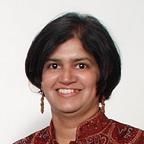Numbers without narratives and narratives without numbers
We need data stories.
We have a problem with the way we approach water data in practice. Good decision-making in the water sector requires both good data and using the data for better decision-making. Yet we have found that what’s crucial is narratives that are backed up by numbers.
Numbers without narratives:
Water data scarcity remains a problem in India. We simply don’t have the data we need to answer important questions. Our recent report on Commercial, Industrial, Institutional Water Use in Bangalore shows that even when the question is important and data are carefully and painstakingly assembled, it’s difficult to tell a story, because of the huge uncertainties and gaps in publicly available datasets.
But it is not just the absence of data; public data often has such large error bars or systematic biases so as to not be useful. Groundwater levels in hard-rock peninsular India are a classic example of this blinkered vision. In our field studies, we have sometimes found that government monitoring well data to be much shallower than both our own observation data (from borewell scans and water level recorders) and farmer reports. A deeper investigation revealed systematic biases in the way data are collected and used. Yet, not much has changed in the scientific discourse.
Finally, many disciplines do not have a culture of using numbers to tell stories. In the water sector, data are used to develop predictive models, but modellers rarely reflect on the meaning or implications of the water level or salinity trends observed and simulated. Do the water levels make sense given the changes in land use observed from space? Do they correlate with what farmers are saying? Why did the levels drop in one district but not the adjacent district? Stories from the field that contradict numerical models are dismissed as “hearsay”. So even when the data are incorrect or biased, no alarm is raised.
Narratives without numbers:
At the other end of the spectrum, equally problematic are glib stories of transformative change, where big claims of impact are made through effective storytelling accompanied by images.
For often, claims of dramatic rural transformation are common in the water sector. But this is often not sufficient to assign attribution as there are a number of confounding factors. For example, a community-based organisation, engaged in building check dams might offer Google Earth images as proof of changes in greening pre- and post-construction. However, it would be difficult to tell whether the increase in greenery is due to the check dam or due to good rains in the preceding year. There is a need for story-telling, but it must be backed by sound data analyses.
Using numbers to weave narratives:
What’s needed is data-based storytelling.
Of course, this also requires us to reflect deeply on what stories the data tell and about who. Often data are biased, reflecting the concerns of the privileged. An inherent bias in the water sector, for instance, is the continued focus on irrigated farmers, even though almost half of India’s farmers and food grain production are rainfed. Rainfed farmers are much poorer and vulnerable than irrigated farmers.
This requires a change in the culture of data collection and use. It requires us to ask the right questions, analyse the data correctly, formulate a narrative, triangulate against other narratives, and position the data analysis for use by stakeholders in specific use cases, and using effective communication.
In this series of blogs from our Food Futures Initiative, we reflect on our own journey in enabling data to improve rural water security. These insights emerged from conversations with stakeholders, learning circles, primary analyses of water security plans and digital tools as well as a systematic review of insights from monitoring and evaluation reports.
Read more of the Rural Water blog series
Part 1: How do we make a dent in rural water security?
Part 2: Is data informing decisions in rural water security?
